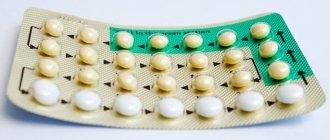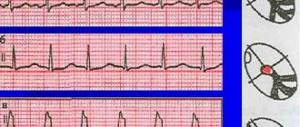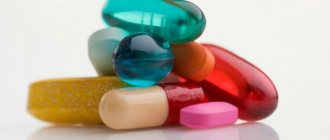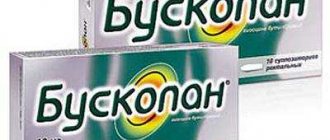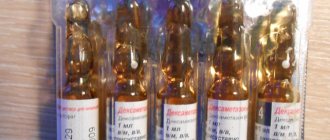Composition and release form
Proserin is a drug that has two release forms. These are oral tablets and parenteral solution :
| Pills | Solution | |
| Description | White round | Transparent colorless liquid |
| Concentration of neostigmine methyl sulfate, mcg | 15 per 1 pc. | 500 per 1 ml |
| Auxiliary components | Calcium stearate, potato starch, sucrose | Water for injections |
| Package | Packages of 10 pcs., 2 packs per pack | Ampoules 1 ml, 10 pcs. in a pack |
Prozerin
Prozerin is a drug that helps restore neuromuscular conduction and tones skeletal muscles.
Release form and composition
Dosage forms of release of Proserin:
- Tablets: white, flat-cylindrical, with a bevel (10 pieces each in blister packs, 2 packs in a cardboard box);
- Solution for injection: colorless, transparent (in ampoules of 1 ml, in a cardboard pack of 10 ampoules or 5 ampoules in blister packs, in a cardboard pack of 2 packs);
- Solution for intravenous and subcutaneous administration: colorless, transparent (in ampoules of 1 ml, in a cardboard pack of 10 ampoules or 5 or 10 ampoules in blister packs, in a cardboard pack of 1 or 2 packs).
Composition of 1 tablet:
- Active substance: neostigmine methyl sulfate (prozerin) – 15 mg;
- Additional components: sugar (sucrose) – 64 mg, potato starch – 20 mg, calcium stearate monohydrate – 1 mg.
Composition of 1 ml solution for subcutaneous and intravenous administration and for injection:
- Active substance: neostigmine methyl sulfate (prozerin) – 0.5 mg;
- Additional component: water for injection – up to 1 ml.
- Paralysis;
- Motor disorders after brain injury;
- Optic nerve atrophy;
- Myasthenia;
- Neuritis;
- The recovery period after polio, meningitis, encephalitis;
- Atony of the bladder and intestines (treatment and prevention);
- Labor activity (for stimulation).
As an antidote, Prozerin is prescribed after anesthesia with the use of muscle relaxants (antidepolarizing and depolarizing (if they act like antidepolarizing “double block”)) for respiratory depression and muscle weakness.
Side effects
- Respiratory system: shortness of breath, increased bronchial and pharyngeal secretion; respiratory depression to the point of stopping, bronchospasm (most often with parenteral administration);
- Digestive system: nausea, flatulence, hypersalivation, spastic contractions and increased intestinal motility, vomiting, diarrhea;
- Sense organs and nervous system: drowsiness, weakness, blurred vision, dizziness, headache, convulsions, loss of consciousness, miosis, dysarthria;
- Blood (hematopoiesis, hemostasis) and cardiovascular system: syncope, junctional rhythm, arrhythmia, brady- or tachycardia, cardiac arrest, atrioventricular block, nonspecific changes in the electrocardiogram, decreased blood pressure (most often with parenteral administration);
- Others: profuse sweating, dysarthria, arthralgia, increased urination, convulsions, tremors, twitching and spasms of skeletal muscles, including fasciculations of the tongue muscles, allergic reactions (in the form of facial flushing, rash, itching, anaphylaxis).
In order to reduce the severity of adverse reactions, it is necessary to reduce the dose or stop using Proserin; if necessary, administration of atropine (1 ml of 0.1% solution), methocinium iodide or other anticholinergic agents is indicated.
Drug interactions
In the treatment of myasthenia gravis, Prozerin is prescribed simultaneously with anabolic hormones and glucocorticosteroids.
When Proserin is used in combination with certain drugs/substances, the following effects may develop:
- Atropine, methocinium iodide and other m-cholinergic blockers: weakening of m-cholinomimetic effects (possible development of bradycardia, pupil constriction, increased gastrointestinal motility, hypersalivation and other symptoms);
- depolarizing muscle relaxants (suxamethonium iodide, etc.): enhancing their effects (pharmacologically incompatible);
- Cyanocobalamin (in large doses): weakening of the effect of neostigmine methyl sulfate;
- Pyridoxine: decrease in its activity;
- Ephedrine: potentiation of the action of neostigmine methyl sulfate (combined use is indicated for myasthenic crises).
It must be taken into account that the pharmacological antagonists of Proserin are: local anesthetics, m-anticholinergic blockers (atropine, homatropine hydrobromide, platyphylline, etc.), ganglion blockers (quinidine pachycarpine hydroiodide), novocainamide. Relative antagonism has been observed with tricyclic antidepressants, antiparkinsonian and antiepileptic drugs.
Mechanism of action of Proserin
The active component of the composition is an inhibitor of acetylcholinesterase and pseudocholinesterase. The substance has an indirect cholinomimetic effect and potentiates the effect of endogenous acetylcholine. Neostigmine increases the transmission between cells of nervous and muscle tissue, enhances the motility of the digestive tract, improves the tone of the smooth muscle muscles of the bronchi and bladder.
Taking the drug can cause bradycardia, a decrease in blood and intraocular pressure, mydriasis (constriction of the pupil), and the appearance of a spasm of accommodation. If you take a large dose of the medication, acetylcholine will accumulate, which will lead to disruption of neuromuscular conduction.
The drug excites cholinergic nerves and does not have a central effect or influence on the heart. After oral administration or parenteral administration, neostigmine is hydrolyzed in the liver; after metabolism, inactive metabolites are formed. The substance binds to plasma proteins by 20% and is excreted by the kidneys. 80% of the components are excreted from the body within a day, 50% of the dose forms metabolites. Neostigmine does not penetrate the meningeal barrier well.
pharmachologic effect
The pharmacological group of the drug is a cholinesterase inhibitor. This is a synthetic anticholinesterase drug that reversibly blocks cholinesterase. As a result of this action, acetylcholine accumulates and its effect on tissues and organs increases. As a result, neuromuscular conduction is restored.
Under the influence of the drug, the heart rate decreases, the secretion of the bronchial, salivary, sweat glands, as well as the glands of the digestive tract increases. In turn, this contributes to the manifestation of bronchorrhea, hypersalivation, and an increase in the level of acidity of gastric juice.
The active substance causes a spasm of accommodation, constriction of the pupil, lowers intraocular pressure, stimulates the tone of the smooth muscles of the intestines and bladder, tones the skeletal muscles, and provokes bronchospasm.
We suggest you familiarize yourself with Cracks on the penis (penis)
Prozerin is an antagonist of anti-depolarizing curare-like drugs. When taking large doses, the drug can provoke a disorder of neuromuscular conduction, which occurs due to the accumulation of acetylcholine. Produces a direct n-cholinomimetic effect. The effect of the drug coincides with the characteristic effects of excitation of cholinergic nerves.
Indications for use of Proserin
Proserin is a widely active drug, so the range of its indications for use is wide. The instructions highlight the following:
- myasthenia gravis, myasthenic syndrome;
- optic nerve atrophy;
- disorders of the motor system after brain injury;
- weakness of labor;
- paralysis;
- recovery from meningitis, polio, encephalitis;
- neuritis;
- elimination of residual disturbances in transmission between nerves and muscles with non-depolarizing muscle relaxants;
- atony of the intestines, stomach or bladder;
- constriction of the pupil, open-angle glaucoma.
Pharmacological group
| Category ICD-10 | Synonyms of diseases according to ICD-10 |
| B91 Consequences of polio | Polio consequences |
| Post-polimyelitic syndrome | |
| G03.9 Meningitis, unspecified | Arachnoiditis |
| Subacute meningitis | |
| Consequence of meningitis | |
| Serous meningitis | |
| Cerebral meningitis | |
| G09 Consequences of inflammatory diseases of the central nervous system | Consequence of encephalitis |
| Consequences of meningitis | |
| G70 Myasthenia gravis and other neuromuscular junction disorders | Myasthenic syndromes |
| Myasthenic syndrome | |
| Myasthenia gravis | |
| Myasthenic syndrome | |
| Myasthenia gravis | |
| G83.9 Paralytic syndrome, unspecified | Bulbar paresis |
| Bulbar paresis | |
| H40.1 Primary open-angle glaucoma | Open angle glaucoma |
| Open angle glaucoma | |
| Primary glaucoma | |
| Increased IOP | |
| Pseudoexfoliation glaucoma | |
| H46 Optic neuritis | Inflammation of the optic nerve |
| Inflammatory neuritis of the optic nerve | |
| Papillitis | |
| Leber's retinitis | |
| Strawn syndrome | |
| K31.8.0* Gastric atony | Atony of the gastrointestinal tract |
| Gastric hypotension | |
| Diabetic gastroparesis | |
| Idiopathic gastroparesis | |
| Drug-induced gastroparesis | |
| Gastric paresis | |
| Paresis of the stomach and intestines | |
| Postoperative gastric atony | |
| Postoperative gastric hypotension | |
| K59.8.0* Intestinal atony | Duodenal atony |
| Atony of the gastrointestinal tract | |
| Intestinal atony | |
| Intestinal atony after surgery | |
| Intestinal atony after childbirth | |
| Atony of the gastrointestinal tract muscles | |
| Sluggish peristalsis of the large intestine | |
| Sluggish colon peristalsis | |
| Duodenal hypotension | |
| Intestinal hypotension | |
| Hypotension of the large intestine | |
| Hypotension of the colon | |
| Constipation of various etiologies, caused by hypotension of the gastrointestinal tract and sluggish peristalsis of the large intestine | |
| Impaired movement of intestinal contents | |
| Postoperative gastric atony | |
| Postoperative intestinal atony | |
| M79.2 Neuralgia and neuritis, unspecified | Pain syndrome with neuralgia |
| Brachialgia | |
| Occipital and intercostal neuralgia | |
| Neuralgia | |
| Neuralgic pain | |
| Neuralgia | |
| Neuralgia of the intercostal nerves | |
| Neuralgia of the posterior tibial nerve | |
| Neuritis | |
| Traumatic neuritis | |
| Neuritis | |
| Neurological pain syndromes | |
| Neurological contractures with spasms | |
| Acute neuritis | |
| Peripheral neuritis | |
| Post-traumatic neuralgia | |
| Severe neurogenic pain | |
| Chronic neuritis | |
| Essential neuralgia | |
| N31.2 Neurogenic bladder weakness, not elsewhere classified | Bladder atony |
| Atony of the bladder (sphincter) (neurogenic) | |
| Urgent incontinence | |
| Bladder sphincter dysfunction | |
| Urinary incontinence in stressful situations | |
| Neurogenic bladder dysfunction | |
| Neurogenic bladder disorders | |
| Neurogenic bladder | |
| Functional insufficiency of the bladder sphincter | |
| O62.2 Other types of labor weakness | Activation of labor |
| Uterine atony | |
| Induction of labor | |
| Induction of labor during full-term pregnancy | |
| Induction of labor in full-term or almost full-term pregnancy | |
| Decreased uterine tone | |
| Weakness of labor | |
| T48.1 Poisoning with muscle relaxants [skeletal muscle n-cholinergic receptor blockers] | Antidote for muscle relaxants |
| T90.9 Sequelae of unspecified head injury | Post-traumatic syndrome in traumatic brain injuries |
| Condition after traumatic brain injury | |
| Condition after TBI | |
| Z100.0* Anesthesiology and premedication | Anesthesia |
| Anesthesia in otorhinolaryngological practice | |
| Anesthesia in dentistry | |
| Arterial hypotension during spinal anesthesia | |
| Ataralgesia | |
| Basic anesthesia | |
| Fast anesthesia | |
| Introduction to anesthesia | |
| Introductory anesthesia | |
| Excitement before surgery | |
| mechanical ventilation | |
| Inhalation anesthesia | |
| Inhalation anesthesia for major and minor surgical interventions | |
| Induction and maintenance of general anesthesia | |
| Intraligamentary anesthesia | |
| Tracheal intubation | |
| Artificial hibernation | |
| Cardioplegia | |
| Caudal anesthesia | |
| Caudal block | |
| Combined anesthesia | |
| Short-term anesthesia | |
| Short-term infiltration anesthesia in surgery | |
| Short-term local anesthesia | |
| Short-term muscle relaxation | |
| Lumbar anesthesia | |
| Local anesthesia | |
| Local infiltration anesthesia | |
| Local superficial anesthesia | |
| Muscle relaxation | |
| Muscle relaxation during mechanical ventilation | |
| Muscle relaxation during surgical interventions | |
| Muscle relaxation during operations | |
| Muscle relaxation during mechanical ventilation | |
| Monocomponent anesthesia | |
| Nasogastric intubation | |
| Anesthesia | |
| Non-inhalation anesthesia for surgical delivery | |
| Immediate pain relief | |
| General anesthesia | |
| General anesthesia for short-term surgical interventions | |
| General anesthesia | |
| Premedication period | |
| Superficial anesthesia in ophthalmology | |
| Maintaining anesthesia | |
| Preoperative period | |
| Premedication | |
| Conduction anesthesia | |
| Regional anesthesia | |
| Relaxation of skeletal muscles | |
| Mixed anesthesia | |
| Spinal anesthesia | |
| Spinal anesthesia | |
| Spinal anesthesia | |
| Terminal anesthesia | |
| Controlled breathing during anesthesia | |
| Epidural anesthesia |
We suggest you read: Ceftriaxone instructions for use injections with lidocaine how to dilute
Directions for use and dosage
Instructions for use of Prozerin are different for each form of release of the drug. The tablets are taken orally, the solution can be administered intravenously or subcutaneously. There is also a children's version of the medicine - in the form of granules that are diluted with water, the resulting emulsion is taken orally. The dosage and course of treatment depend on the severity of the disease and are prescribed by a doctor.
In tablets
The medication in tablet format is taken half an hour before meals. Adults are prescribed 10-15 mg 2-3 times a day . The maximum single dose is 15 mg, the daily dose is 50 mg of the drug. Children under 10 years of age are prescribed 1 mg per year of life per day, older children - 10 mg per day. The course of treatment lasts 25-30 days, after 3-4 weeks it can be continued. The maximum portion of the dose taken per day is consumed at the moment of greatest fatigue.
If labor is weak, take 3 mg 4-6 times a day every 40 minutes. For motor impairment after brain injury, encephalitis, meningitis, paralysis, take 15 mg orally 1-2 times a day for 2-3 weeks. If restoration of brain activity is required after polio, take 15 mg every day or every other day in a course of 15-20 doses.
In injections
Injections of the solution are administered subcutaneously or intramuscularly. To prevent atony of the bladder and intestines caused by surgical interventions, 0.25 mg of the drug is administered subcutaneously or intramuscularly, then repeat the dosage every 4-6 hours for three days. To treat urinary retention, 0.5 mg of Proserin is administered.
If diuresis does not return to normal after an hour, the instructions recommend catheterization. Then Prozerin in ampoules is used every 3 hours, a total of five injections are used. For children, the medication is administered subcutaneously or intramuscularly for the treatment of myasthenia gravis (gravis) - at a dosage of 0.05 mg per year of life per day, maximum 0.375 mg at a time. The daily dose is administered once or in 2-3 injections. In ophthalmology, the solution can be injected into the eye cavity 1-4 times a day.
Articles on the topic
- Champix - instructions for use, mechanism of action, contraindications, side effects and analogues
- Omnik - instructions and mechanism of action, contraindications, side effects, dosage regimen and analogues
- Formidron - instructions for use, side effects, contraindications, mechanism of action and analogues
Solution for intravenous and subcutaneous administration
For myasthenic crisis, Prozerin is administered intravenously at a dose of 0.2-0.5 mg in combination with saline solution 0.9%, then subcutaneously. If it is necessary to enhance the effect of the drug, an additional 1 ml of 5% ephedrine is injected subcutaneously. To stimulate labor, 0.5 mg is administered subcutaneously, repeated every hour. With the first dose of Prozerin, atropine is additionally administered.
If it is necessary to stop the effect of muscle relaxants, first 0.5-0.7 mg of atropine is administered intravenously, when the pulse quickens (this is about 1-2 minutes), then 1.5 mg of Proserin is used intravenously. If there is no effect, the dose is repeated, but not more than 5-6 mg of neostigmine in 25 minutes. When performing the procedure, it is necessary to ensure ventilation of the lungs.
Instructions for use of Prozerin in ampoules
Prozerin injections are intended to restore the normal transmission of nerve impulses coming from the brain to smooth and skeletal muscles. Thanks to the active substance of the drug, it is possible to treat myasthenia gravis, organ atony and reduce intraocular pressure. The solution is administered to both adults and children in a strictly specified dosage.
Composition and release form
The medication is available in the form of an injection solution necessary for intensive care. Medicinal properties are determined by the active substance - 0.5 mg neostigmine methyl sulfate. To administer the active compound parenterally, an auxiliary component is used - purified water.
Prozerin in the form of a solution is produced in 1 ml ampoules. The bottles are made of ordinary glass. Externally, the medicine is a colorless, transparent, odorless liquid.
Pharmacological properties
Prozerin is an injection that, after administration, suppresses the activity of the enzyme acetylcholinesterase. It is found in synapses and promotes the breakdown of acetylcholine, a neurotransmitter that allows the transmission of electrical impulses from the brain to the muscles. When it is broken down by acetylcholinesterase, it is converted to choline and stops acting on neuromuscular fibers.
Thanks to the action of the drug, the breakdown of the neurotransmitter stops and its amount increases. As a result, a stimulating effect is observed:
- the production of sweat, saliva, and protective mucus in the bronchi increases;
- the pupils narrow and intraocular pressure decreases;
- the synthesis of hydrochloric acid and digestive enzymes in the stomach increases;
- peristalsis of intestinal smooth muscles increases;
- relaxation of the sphincters occurs, contraction of the hollow organs of the urinary system;
- blood pressure decreases;
- the tone of skeletal muscles increases, the contractility of muscle fibers improves.
The active component practically does not penetrate the blood-brain barrier, and therefore does not affect brain function. The drug affects only the parasympathetic nervous system.
Indications and contraindications for use
Prozerin helps in the following cases:
- optic nerve atrophy;
- muscle weakness and paralysis of varying severity;
- recovery after surgery on the digestive tract;
- open-angle form of glaucoma;
- damage to the facial nerve and its processes;
- disorder of the muscles of the limb resulting from injury;
- during the rehabilitation period after treatment of encephalitis and inflammation of the meninges;
- impaired peristalsis or lack of tone of the smooth muscles of the excretory system: intestines and bladder.
In some cases of gynecological practice, if necessary, the medication is used to facilitate labor. In pediatrics, it is used to treat neurological disorders due to its stimulating effect on neuromuscular conduction.
Proserin injection solution is prohibited from being administered in the following conditions:
- severe bradycardia;
- intestinal obstruction;
- acute form of ulcerative lesions of the stomach and duodenum with a high risk of perforation;
- severe atherosclerosis of the main arteries, blockage of their lumen by cholesterol plaques by more than 20%;
- acute bacterial or viral infection;
- severe thyrotoxicosis;
- bladder obstruction;
- benign prostatic hyperplasia;
- severe myocardial ischemia, angina pectoris;
- frequent attacks of bronchial asthma;
- hypersensitivity to neostigmine methyl sulfate;
- epilepsy;
- peritonitis.
Instructions for the use of Proserin injections intramuscularly
Prozerin can be injected intravenously, injected under the skin or into the deep layer of muscle tissue. The procedure is carried out in a hospital.
Directions for use and doses
The dosage of Prozerin is prescribed depending on the type of pathological process:
- Myasthenia gravis: the maximum permissible dose of the drug per day is 0.5 mg, in the acute form of myasthenic crisis - 1 mg. Injections are given intramuscularly or under the skin. The methods of administering the medication are alternated.
- Rehabilitation after surgery on the organs of the urinary and digestive system: inject into the gluteal muscle 0.25 mg per day. The course of therapy lasts from 3 to 4 days.
- Overdose of drugs with a muscle relaxant effect: administered as a dropper, diluted with 0.5 mg of the active substance in physiological solution. If necessary, the dose can be increased to 2 mg. Intravenous drip administration is carried out over 20 minutes. Therapy can be repeated.
- Lack of peristalsis of the bladder and intestinal tract. The dosage per day is 0.25 to 0.5 mg. Intramuscular or subcutaneous injections are given.
Overdose and possible side effects
Using the drug in large quantities can lead to an overdose. The body is subjected to a powerful stimulating effect, which can lead to the development of a cholinergic crisis. This occurs as a result of overexcitation of receptors sensitive to the neurotransmitter acetylcholine in synapses. In this case, the following clinical picture arises:
- respiratory failure develops;
- heart rate increases sharply;
- the victim cannot swallow;
- pathological bronchospasm is observed;
- intestinal peristalsis of smooth muscles increases, diarrhea is possible;
- skeletal muscle spasms appear;
- involuntary urination develops;
- the feeling of anxiety increases, panic attacks appear;
- nausea and vomiting occur due to stomach cramps;
- blood pressure drops;
- coordination of movements is impaired;
- it is possible to develop paralysis of the limbs or, conversely, muscle weakness.
In case of overdose, the patient is hospitalized and given comprehensive treatment aimed at eliminating his symptoms. In this case, drug therapy is stopped and atropine is administered.
Prozerin in ampoules, the instructions for use of which require strict dosage, can lead to the following negative consequences if used incorrectly:
| Internal organs and systems | Side effects |
| Gastrointestinal tract |
|
| Circulatory system |
|
| Respiratory system |
|
| The immune system |
|
| CNS and PNS |
|
| Organs of the urinary system |
|
| General violations |
|
special instructions
The drug should be administered with caution to pregnant and lactating women and people with Addison's syndrome. If long-term therapy with Proserin with a high concentration of the active substance is planned, in order to prevent an overdose, the patient simultaneously receives atropine.
Use during pregnancy and lactation
The active component of Prozerin partially penetrates the placental barrier and can increase the tone of the uterus, which will lead to miscarriage and premature birth. Therefore, whenever possible, use a safer analogue.
The active compound is excreted in breast milk.
Patients during lactation are recommended to transfer the newborn to feeding with artificial formulas to avoid the development of symptoms of an overdose or an allergic reaction in the baby.
Injections for children
In most cases, Prozerin is administered subcutaneously to children. For infants under 1 year of age, it is used to eliminate myasthenia gravis. The dosage is determined at the rate of 0.05-0.3 mg per 1 kg of weight. It is prohibited to administer more than 0.75 ml of an ampoule, otherwise the risk of overdose increases. Children under 12 years of age are prescribed injections of 0.2-0.5 mg per day.
It is strictly forbidden to administer the drug to children against the background of general intoxication. Severe poisoning by viruses, chemicals, toxins or food weakens the child’s body. He may not respond adequately to the drug, which increases the risk of side effects. Possible death.
Drug interactions and compatibility with alcohol
The therapeutic effect of the drug is reduced when used in parallel:
- antiepileptic drugs;
- local painkillers;
- anticholinergics type M and H;
- psychotropic drugs;
- quinidine;
- medications aimed at treating Parkinson's disease;
- Novocainamide.
Ephedrine and its analogues enhance the effect of Proserin, so they are also not recommended for use at the same time. Neostigmine methyl sulfate increases the effect of depolarizing muscle relaxants and is an antidote to non-depolarizing muscle relaxants. Beta-blockers, when administered together with Proserin injections, lead to the development of severe bradycardia.
It is prohibited to drink alcoholic beverages during drug therapy. The ethyl alcohol they contain reduces the therapeutic effect of the drug. Because of this treatment does not occur, there is a need to increase the duration of therapy. As a result, the risk of developing negative effects and overdose increases.
Effect on reaction
The medicine affects the transmission of nerve impulses to different parts of the body, and therefore can reduce the body’s reaction rate. As a result, during the period of treatment with Proserin, you should avoid driving a car, working with complex devices and playing extreme sports.
Terms of sale and storage
The medicine should be kept in a place with low humidity, away from exposure to sunlight and other sources of ultraviolet radiation. At temperatures below +25°C, storage is allowed for 3 years from the date of release.
The drug is purchased only with a prescription.
Analogs (briefly)
Substitutes for Proserin are drugs that have a similar therapeutic effect due to the similarity of the chemical composition. Such means include:
- Amiridine;
- Neostigmine methyl sulfate;
- Oxazyl;
- Ubretid;
- Armin.
Some analogues can be used in tablets, like Proserin for oral use.
Source: https://oVakcine.ru/instruktsii/instruktsiya-po-primeneniyu-prozerina-v-ampulah
special instructions
The medication is prescribed with caution for Addison's disease. High doses of the solution require prior or simultaneous administration of atropine. If the dose was insufficient or exceeded, myasthenic and cholinergic crises develop. During treatment with Proserin, the instructions advise to refrain from driving or driving dangerous machinery.
Neostigmine can pass through the placenta and be found in breast milk, so it can be used during pregnancy and breastfeeding (lactation) only under strict indications. To treat children, it is better to use a granular preparation or electrophoresis with an injection solution. All procedures require medical supervision.
Additionally
The drug can be used by children only in a hospital setting.
When parenterally administering large doses, it is necessary (preliminary or simultaneous) administration of atropine.
If a myasthenic (with insufficient therapeutic dose) or cholinergic (due to overdose) crisis occurs during treatment, further use of the drug requires careful differential diagnosis due to the similarity of symptoms.
Before medical or dental treatment or surgery, you must tell your doctor that you are taking proserine.
The drug should be prescribed with extreme caution to patients after operations on the intestines and bladder, and to patients with parkinsonism.
The ability to influence the reaction rate when driving vehicles or other mechanisms
During the treatment period, it is prohibited to drive vehicles or engage in other potentially hazardous activities that require increased concentration and speed of psychomotor reactions.
Drug interactions
Neostigmine is an antagonist of non-depolarizing muscle relaxants, and therefore can enhance the effect of depolarizing drugs of this group. With simultaneous use, ganglion blockers, procainamide, m-anticholinergic adenosine triphosphate, local anesthetics, quinidine, tricyclic antidepressants, antiparkinsonian, antiepileptic drugs, anesthesia drugs reduce the effect of Proserin. Its effect can be potentiated by ephedrine, and when combined with beta-blockers, bradycardia develops.
Side effects
Taking Prozerin may be accompanied by side effects. Instructions for use highlight the following:
- spastic contraction of the muscles of the digestive tract, vomiting, flatulence, diarrhea;
- dysarthria, convulsions, dizziness, muscle twitching, weakness, blurred vision, drowsiness;
- decreased pressure, arrhythmia, atrioventricular block, bradycardia, tachycardia;
- hypersalivation;
- dystrophy;
- disruption of the exocrine glands;
- hemostasis disorders;
- dyspnea;
- allergic reactions, anaphylaxis, skin rash, facial flushing, itching;
- arthralgia;
- tremor;
- obstruction of the digestive tract;
- reduction in thiamine secretion;
- increased acidity of gastric juice;
- frequent urination;
- increased sweating.
An overdose of the drug is manifested by overexcitation, bradycardia, bronchospasm, nausea, and diarrhea. In humans, intestinal motility increases, urination becomes more frequent, the tongue twitches, blood pressure decreases, and general weakness develops. To treat an overdose, 1 ml of a 0.1% solution of atropine sulfate, metacin or other anticholinergic drugs (m-choline blockers) is administered. There is no antidote to relieve symptoms.
Possible side effects
During treatment, side effects may occur. Disturbances are observed in different body systems:
- digestive disorders: bloating, nausea and vomiting, diarrhea, frequent urge to defecate, smooth muscle spasm (manifested by severe pain in the stomach);
- disorders of the heart and blood vessels: arrhythmia, changes in heart rate, decreased blood pressure. In some severe cases, the heart may stop;
- side effects from the sensory organs: visual disturbances, constriction of the pupils, lacrimation;
- nervous system disorders: dizziness, headaches, confusion, weakness, drowsiness, twitching of skeletal muscles, spasms, numbness of the legs and speech disorders;
- allergic reactions: rashes resembling a nettle burn, itching and burning, redness. In some cases, angioedema and anaphylactic shock are possible, requiring immediate medical attention;
- changes in the musculoskeletal system, which manifest themselves as pain in the joints;
- changes in the urinary system: involuntary loss of urine, increased urge to urinate.
Side effects are more pronounced with long-term use or the presence of allergic reactions.
Important! If you have side effects, do not delay visiting your doctor. The specialist will decide to replace Proserin with another drug or change the dosage to a safer one.
Contraindications
The drug should not be taken by certain groups of patients. The instructions highlight contraindications:
- epilepsy;
- bronchial asthma;
- hyperkinesis;
- vagotomy;
- coronary heart disease, angina pectoris, arrhythmia, bradycardia;
- thyrotoxicosis;
- severe atherosclerosis;
- mechanical obstruction of the digestive tract;
- prostate hyperplasia;
- stomach ulcer, duodenal ulcer;
- peritonitis;
- acute infectious diseases;
- intoxication, weakened condition;
- hypersensitivity to the components of the composition.
The drug is used with caution in myasthenia gravis in children, with isomaltase malabsorption syndrome, while taking anticholinergic drugs, neomycin, streptomycin, kanamycin, antibiotics with an antidepolarizing effect, local and general anesthetics. Caution should be exercised when using Proserin simultaneously with antiarrhythmic drugs, glucocorticosteroids, the hormone homatropin and drugs that disrupt cholinergic transmission.
Analogs
Medicines can be replaced by drugs based on the same active ingredient, or another, but with a similar therapeutic effect. These include:
- Neostigmine methyl sulfate is a direct analogue of the drug and is its generic version (cheaper in price);
- Ubretide is an anticholinesterase agent in the form of tablets and solution based on distigmine bromide or iodide;
- Armin is a cholinomimetic for the treatment of glaucoma;
- Amiridine is a tableted cholinomimetic that eliminates myasthenia gravis;
- Oxazyl is a reversible cholinesterase inhibitor containing ambenonium chloride;
- Deoxypeganine hydrochloride or hydrobromide, sodium Niketamide is a reversible cholinesterase inhibitor.
Reviews
Tablets are a group of cholinomimetic drugs with anticholinesterase action. The drug Proserinum is used to treat the nervous system and pathologies characterized by low smooth muscle tone. The medicine Prozerin helps to increase the activity of the bronchial region, has a beneficial effect on gastrointestinal motility, improves the condition of the bladder, is used as an emetic, and is sometimes used to improve labor. The drug slows the heartbeat and helps lower intraocular and blood pressure.
Proserinum is available in the form of creamy pink granules, which are intended for the preparation of suspension and solution for injection in bottles of 60 and 150 ml. Pharmacies also sell white tablets with a rounded, flat-cylindrical surface, intended for oral administration. One package contains 20 pieces. The active component of the drug is neostigmine methyl sulfate.
| Release form | Quantity of active substance | Auxiliary components |
| solution | 0.5 mg/1 ml | |
| pills | 15 mcg/1 tablet. | sucrose, potato starch, calcium stearate |
Proserinum is a synthetic anticholinesterase agent that reversibly blocks cholinesterase. Thanks to this action, acetylcholine accumulates in organs and tissues, enhancing its effect. As a result, neuromuscular conduction is restored in the body. Under the influence of the drug, the secretion of the salivary, bronchial, and sweat glands increases. This contributes to hypersalivation, bronchorrhea, and increased gastric acidity.
If the drug is administered in large doses, then as a result of persistent depolarization in the area of synapses and accumulation of acetylcholine, it itself causes a disturbance in neuromuscular conduction. The effect of the drug coincides with the effects of stimulation of cholinergic nerves. Metabolism of the active substance occurs in the liver, forming inactive metabolites. Binds to proteins by 15-25%. It is excreted from the body by the kidneys throughout the day.
Mechanism of action
The medication has the ability to enhance smooth muscle tone, which helps improve peristalsis and relax the sphincter and bladder. Prozerin causes bronchospasm, tones skeletal muscles, and normalizes the functions of the uterus. The drug is an antagonist of curare-like antidepolarizing drugs and gives a direct cholinomimetic effect. When administered in certain doses, it can significantly enhance neuromuscular transmission.
The use of tablets and injections of the drug Prozerin subcutaneously is prescribed for the following pathologies:
- movement disorders due to brain injury;
- myasthenia gravis;
- recovery from encephalitis, polio, meningitis;
- open-angle glaucoma;
- weak labor activity;
- atony of the bladder, gastrointestinal tract;
- neuritis of the facial or optic nerve;
- optic nerve atrophy, neuritis;
- decreased or absent tone in the walls of the bladder, intestines, and stomach
- neuromuscular transmission disorders;
- paralysis.
During course therapy, taking ethanol-containing drinks is extremely undesirable. When combining the drug with alcohol, orthostatic collapse is possible. Under the influence of ethanol, adrenomimetic effects are enhanced due to the release of adrenaline from the brain, which leads to constriction of blood vessels and contraction of smooth muscles. The patient may experience severe anxiety, increased sweating, tremors of the limbs, nausea, vomiting, facial flushing, and itching.
| Release form | Manufacturer | Price in rubles |
| ampoules 1 ml/10 pieces | Novosibkhimpharm | 62,00 |
| tablets 15 mg/20 pieces | Dalkhimpharm | 56,00 |
Attention! The information presented in the article is for informational purposes only. The materials in the article do not encourage self-treatment. Only a qualified doctor can make a diagnosis and give treatment recommendations based on the individual characteristics of a particular patient.
There are the following indications for the use of Proserin:
- myasthenia gravis;
- paralysis;
- movement disorders after brain injury;
- recovery from polio, meningitis, encephalitis;
- open-angle glaucoma;
- with intestinal atony, atony of the digestive tract as a whole;
- bladder atony;
- neuritis, optic nerve atrophy;
- weak labor (in rare cases);
- in order to eliminate disorders of neuromuscular transmission with non-depolarizing muscle relaxants.
The use of the product for children is practiced in similar cases.
Ubretid
Kalimin 60 N
Axamon
Neuromidin
An analogue of this medicine is Neostigmine methyl sulfate. Analogues by mechanism of action are the drugs Armin, Amiridin, Deoxypeganine hydrochloride, Ubretide, Oxazil.
Reviews of Proserin often mention the side effects of the drug that appear during the treatment process. Most often, dry mouth, drooling, numbness of the tongue, and palpitations are observed. Patients who suffer from myasthenia often leave reviews. Reviews about injections also appear different.
The price of Prozerin in ampoules is from 60 rubles for 10 ampoules. The price at which you can buy injections in Moscow depends on the manufacturer of the product. The price of Prozerin in tablets is from 55 rubles for 20 pcs.
- Online pharmacies in RussiaRussia
- Online pharmacies in UkraineUkraine
- Online pharmacies in KazakhstanKazakhstan
ZdravCity
- Prozerin solution d/in. 0.5 mg/ml 1ml No. 10 NovosibkhimpharmJSC Novosibkhimpharm
Pharmacy Dialogue
- Prozerin (amp. 0.05% 1ml No. 10)
show more
Pharmacy24
- Prozerin-Darnitsa 0.05% 1 ml No. 10 solution PrAT” Pharmaceutical company “Darnitsa”, Ukraine
PaniPharmacy
- Prozerin ampoule Prozerin solution d/in. 0.05% amp. 1ml No. 10 Ukraine, Health of the people LLC
- Prozerin ampoule Prozerin solution d/in. 0.05% amp. 1ml No. 10 Ukraine, OZ GNTsLS LLC
- Prozerin ampoule Prozerin solution d/in. 0.05% amp. 1ml No. 10 Ukraine, Darnitsa ChAO
show more
Proserina price
You can purchase Prozerin through online pharmacies or regular networks. The cost depends on the type of release, packaging volume and level of trade margin . Approximate Moscow prices will be:
| Type of medicine | Manufacturer | Internet cost, rubles | Pharmacy price, rubles |
| Ampoules 0.005% 1 ml 10 pcs. | Novosibkhimpharm | 72 | 80 |
| Ampoules 0.5 mg/ml 1 ml 10 pcs. | Moskhimfarmpreparaty | 23 | 25 |
| Tablets 20 pcs. | 54 | 59 |
Pharmacokinetics and pharmacodynamics
Proserin, which is a quaternary ammonium base, penetrates the blood-brain barrier poorly and does not have a central effect. Bioavailability when administered parenterally is high, 0.5 mg of proserine administered parenterally corresponds to 15 mg taken orally. As the dose increases, bioavailability increases.
When administered, the time to reach maximum concentration in the blood is 30 minutes. Bonding with plasma proteins (albumin) is 15-25%. The half-life (T 1/2) when administered is 51-90 minutes, when administered intravenously - 53 minutes. Metabolized in two ways: due to hydrolysis at the site of connection with cholinesterase and microsomal liver enzymes.
Prozerin should not be mixed in the same syringe with alkaline solutions and oxidizing agents, as this leads to its destruction.
After neostigmine methyl sulfate is administered parenterally, the substance undergoes hydrolysis. Metabolism also occurs in the liver, which produces inactive metabolites. Binds to proteins by 15-25%. It is excreted from the body through the kidneys, with 80% of the substance excreted within 24 hours, with approximately 50% excreted in the form of metabolites. It penetrates poorly through the BBB.

